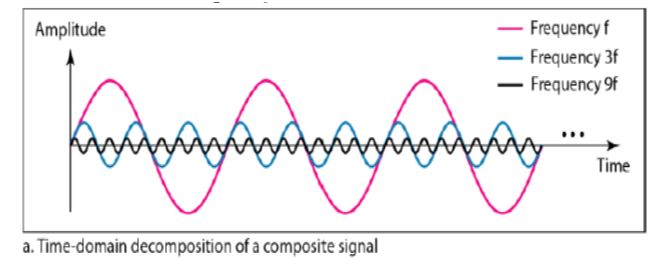Composite Signals In Data Communication
A single-frequency sine wave (simple sine wave) is not useful in data communications; we need to change one or more of its characteristics to make it useful. When we change one or more characteristics of a single, single--frequency signal, it becomes a composite signal made of many frequencies.
A composite signal can be periodic or non-periodic. A periodic composite signal can be decomposed into a series of simple sine waves with discrete frequencies, frequencies that have integer values (1, 2, 3, and so on). A non-periodic composite signal can be decomposed into a combination of an infinite number of simple sine waves with continuous frequencies, frequencies that have real values.
The following figure shows a periodic composite signal with frequency f. This type of signal is not typical of those found in data communications. We can consider it to be three alarm systems, each with a different frequency.
You May Also Like:
Fundamentals of Data and Signals
Digital Signals
Different Methods for Digital Signal Transmission
Decomposition of Composite Signal:
It is very difficult to manually decompose this signal into a series of simple sine waves. The following figure shows the result of decomposing the above signal in both the time and frequency domains.
The amplitude of the sine wave with frequency f is almost the same as the peak amplitude of the composite signal. The amplitude of the sine wave with frequency 3f is one-third of that of the first, and the amplitude of the sine wave with frequency 9f is one-ninth of the first.
The frequency of the sine wave with frequency f is the same as the frequency of the composite signal; it is called the fundamental frequency, or first harmonic.
The sine wave with frequency 3fhas a frequency of 3 times the fundamental frequency; it is called the third harmonic. The third sine wave with frequency 9f has a frequency of 9 times the fundamental frequency; it is called the ninth harmonic.
Note that the frequency decomposition of the signal is discrete; it has frequencies f, 3f, and 9f because f is an integral number, 3f and 9f are also integral numbers. There are no frequencies such as 1.2f or 2.6f. The frequency domain of a periodic composite signal is always made of discrete spikes.
Bandwidth
The range of frequencies contained in a composite signal is its bandwidth. The bandwidth is normally a difference between two numbers. For example, if a composite signal contains frequencies between 1000 and 5000, its bandwidth is 5000 - 1000, or 4000.
You May Also Like:
Transmission Impairment
Different Criteria for Performance of Networks
Back to DCN Questions and Answers

